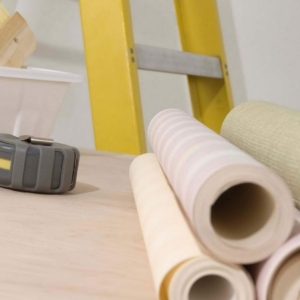Wallpapers - a popular version of the interior of the housing, as the simplicity of work is characterized - for this it is not necessary to invite builders. The most important thing is to calculate and purchase the required amount of material. And the basis of the calculation is the correct measurements. So rode a tape measure - and go ahead!
If old wallpapers remained in the room, and their width is equal to new width, and you do not need to combine the drawing, count the number of bands, measure the height of the wall with the help of a roulette and find out what length of the roll. To date, the roll is 7, 10, 12, 18 meters of wallpaper. To calculate the number of required panels, divide the roll length to the height of the wall.Calculations:
- Say, the standard height of the ceilings is 2.5 meters, in a roll of 10 meters of wallpaper, on the walls of 20 bands of old wallpaper.
- By performing simple manipulations, we obtain the number of cloths from one roll - 4.
- Dividing the number of old segments, in our case 20, by the number of strips from one roll (4), we obtain the number of required rolls, namely 5.
- If you got a fractional number, round it up to the biggest side. So learn how many rolls will need.
- Find the area of \u200b\u200beach wall, multiplying it the length of the width.
- Remove the area of \u200b\u200bthe window or door opening from it in the case of any.
- If you plan on top of the wall not to do the wallpaper, but to re-adjust the space by baguettes, deduct the area and this rectangle.
- Map the results obtained for all walls.
- Translate the value obtained in square meters into rolls. To do this, you need to know the length and width of the wallpaper in the roll to calculate the plane of the panel.
- Divide the area of \u200b\u200bthe room to the Roll Square to find out the number of rolls.
- If on the wallpaper drawing pale or small, you can use when calculating the first or second method.
- But when the image is bright and well noticeable, the pitch of the ornament will have to take into account.
- Typically, the size of the alternating bands is 52-53 cm. If the height of the wall is not divided into this number without a residue, then with some part of the wallpaper, some part of the panel will have to be simply disposed.
- Divide the height of the wall (for example, 2.8 m) per ornament step (0.53 m). Receive
5,28. - Round the value to the biggest. In our case, rapport is 6.
- Multiply the number of repeating rapport (6) on its value (0.53). As a result, we obtain the length of the panel cut off from the roll - 3.18.
- To find out the amount of waste, take away from 3.18 (panel length) 2.8 (wall height). The difference is 0.38 m or 38 cm.
- Divide the roll length (for example, 10) to the strip length (3.18), get the coefficient 3.14.
- Multiply it to the difference of 0.38 m. The final value is 1.19 m.
- Delete it from the total roll length, 10 - 1,19 \u003d 8.81 m.
- Divide the area of \u200b\u200bthe room, which will be bold, on this number, purified from waste - 8.81. And get the number of rolls that you need for repair.

Thus, to calculate the number of wallpapers on the room it is not necessary to invite builders. The rules for determining the number of rolls you already know, whether it is a material with a rapport or ordinary one-photon.
































